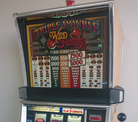The term slot machine face refers to a symbol on a casino game. It can be a coin, card, barcode or other symbol that represents one or more symbols on the reels. When a winning combination occurs, the symbols in that combination pay out credits according to the game’s payout table. A pay table is often displayed above and below the spinning reels or on the screen of a video slot machine. Alternatively, the payout tables are listed in the help menu on most machines.
In the early days of slot machines, players inserted cash or, in Ticket-In, Ticket-Out (TITO) machines, paper tickets with barcodes into slots and pulled a lever to activate them. The player’s hopes were that they would hit a poker-like hand and win prizes, such as beer or cigars, depending on the establishment.
Charles Fey is widely credited with revolutionizing gambling machines in 1898 when he invented the Card Bell, a three-reel slot machine that had staggered stops and an automatic payout design. The machine was a success and it dominated the industry until the age of electronics.
A popular myth is that some machines are “hot” while others are “cold.” There’s no such thing as a hot or cold machine because all spins are predetermined by the computer inside. However, there is a factor that affects how often a particular symbol appears on the reel, and that’s how often it shows up on the previous spin. This is called frequency weighting. It’s not foolproof but it does increase the chances of a specific symbol appearing on the reels.

